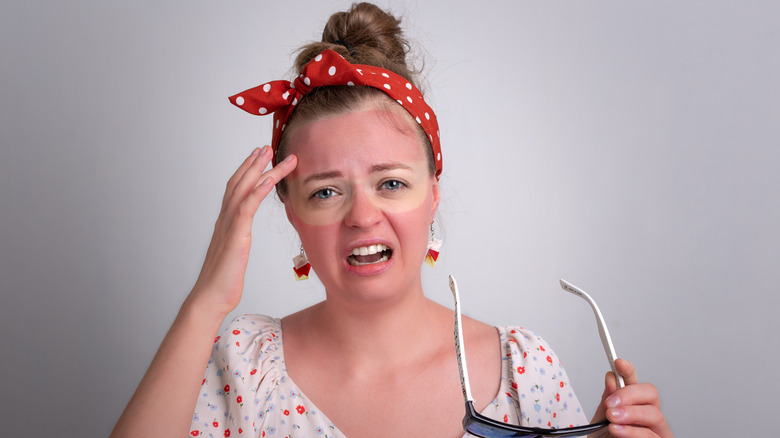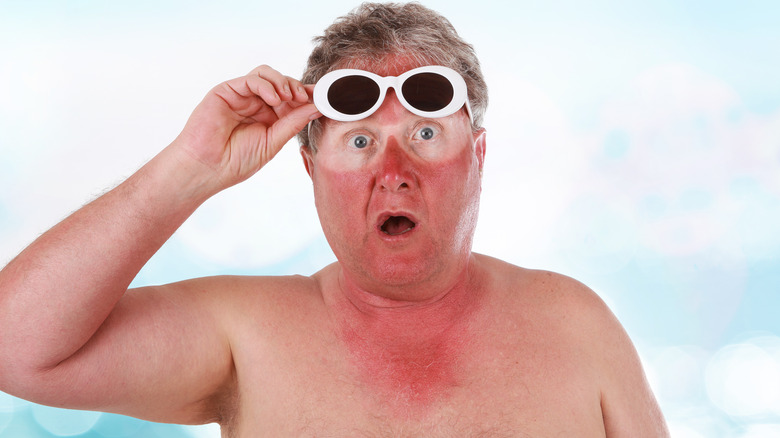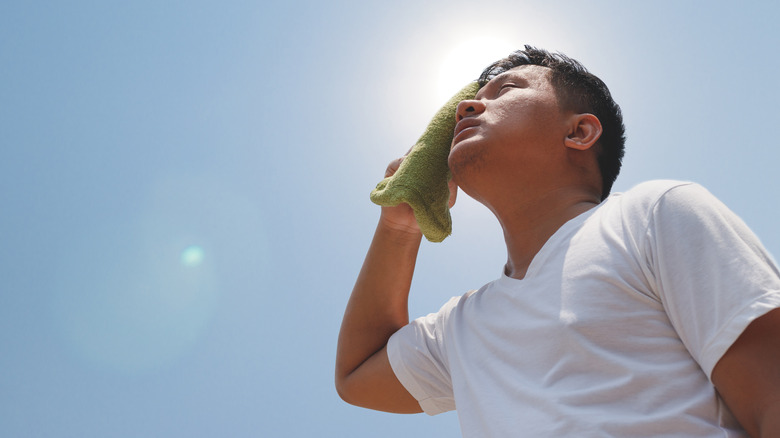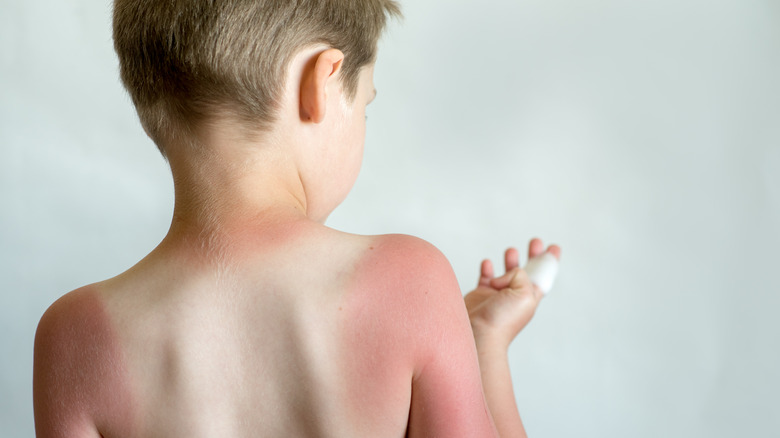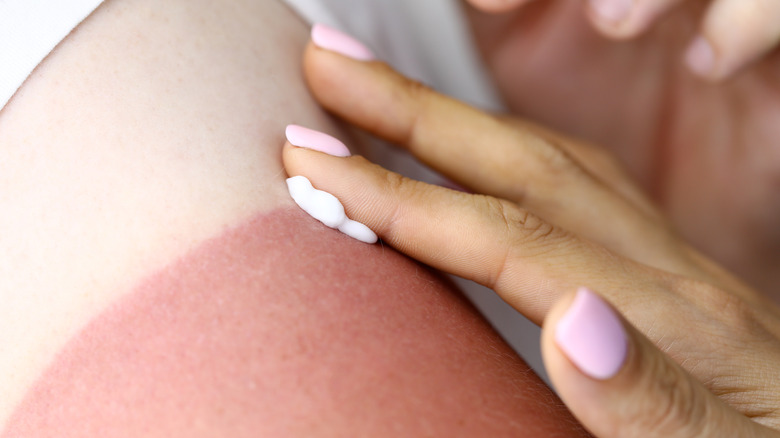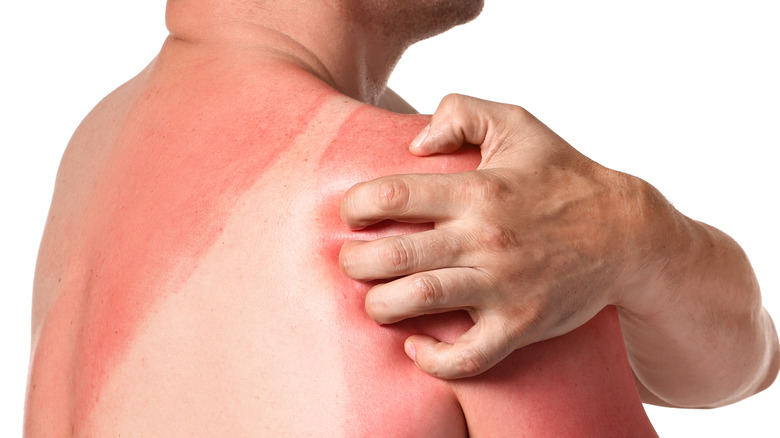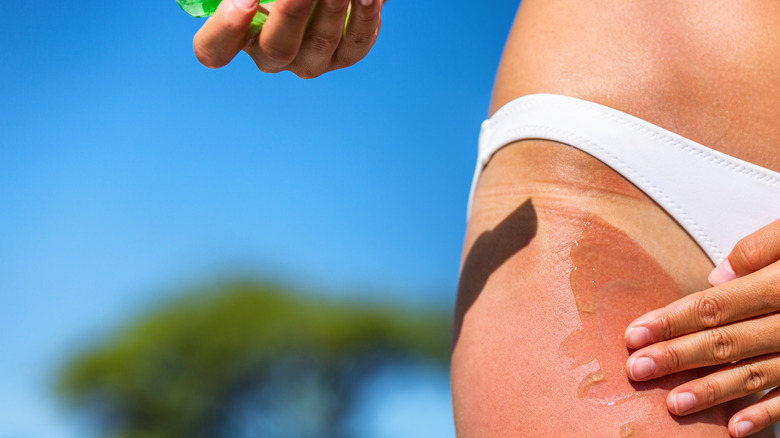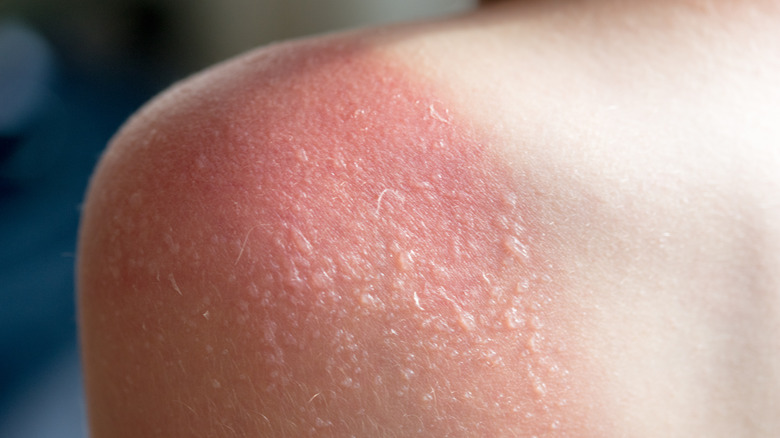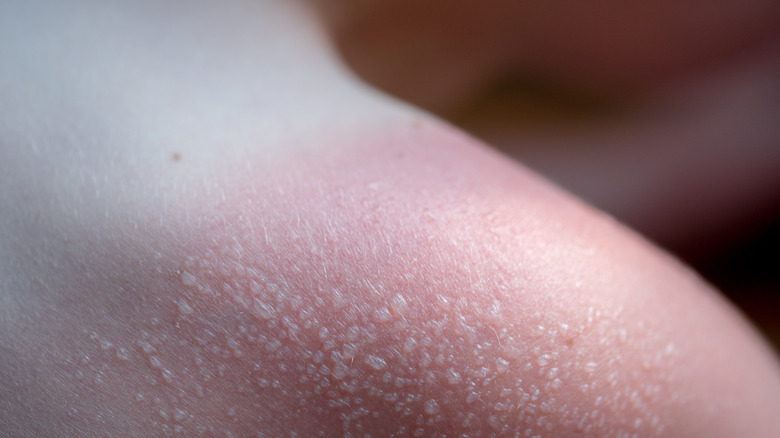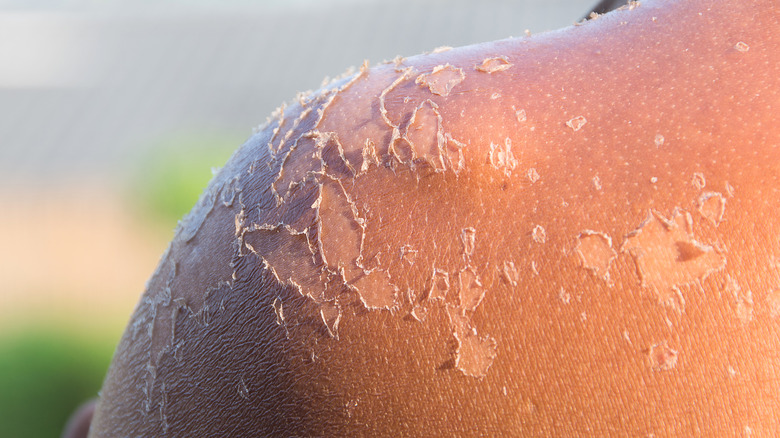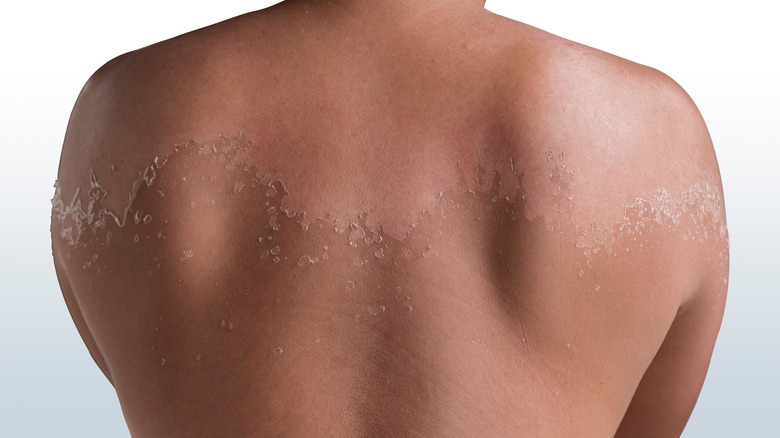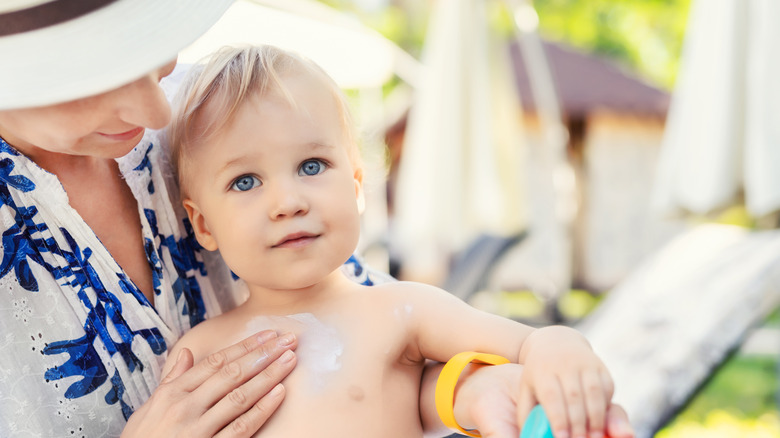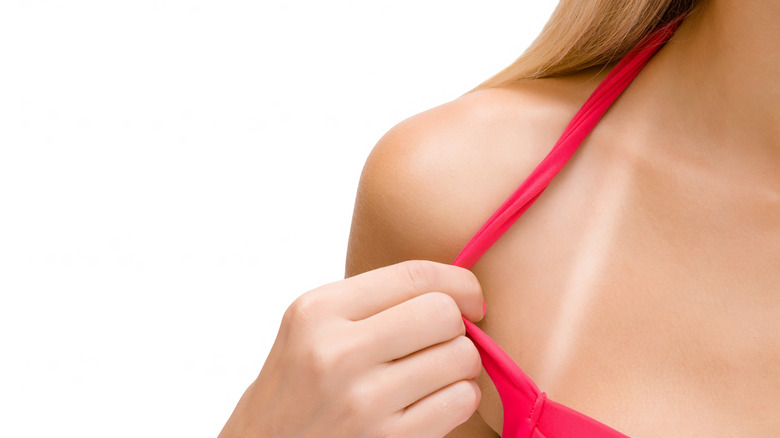What Really Happens To Your Body When You Get A Sunburn
When spring finally rolls around after the seemingly interminable winter, many of us can't wait to get out in the sun. But in our haste and excitement, perhaps we've forgotten just how unforgiving those rays can be. Overdosing on sunlight can lead to that universally detested malady, sunburn. You know what it's like: red, hot skin that's painful to the touch.
If you really, really overdid it, you could even experience painful blistering that leaves you laid up for days — a surefire sign of a second-degree burn. Ouch! Within a few days, your skin will begin to heal, WebMD confirmed. Although you can expect this pain to go away in a relatively short amount of time, there's more to sunburn than meets the eye.
What's actually happening in your body when you get a sunburn? Health Digest spoke with experts to give you all the nitty-gritty details and help you avoid all that unnecessary sun damage in the future.
UVA and UVB rays penetrate your skin
When you go out in the sun, you're actually exposing your skin to ultraviolet (UV) radiation. There are two types of UV rays that penetrate the skin: UVA and UVB. Ultraviolet A is a longer wavelength that can reach deep into the second layer of skin, the dermis, and cause wrinkling and photoaging, Dr. Susan Massick, an associate professor of dermatology at the Ohio State University Wexner Medical Center, told Health Digest. UVB is a shorter wavelength that only reaches the first layer of the skin, the epidermis, and it's these rays that actually cause sunburn, she said. Both types can eventually lead to skin cancer, though.
Your particular risk of sun damage depends in part on your Fitzpatrick skin type, a scale that ranges from 1 (ultra fair complexion with fair hair and eyes) to 6 (darkly pigmented skin with dark hair and eyes), per Healthline. At the low end of the scale, skin that always freckles, burns, and peels, and never tans. On the opposite end, skin never freckles or burns and tans easily and darkly. But other factors can increase your skin's sensitivity to the sun, including taking antibiotics, oral contraceptives, and certain herbal supplements; using alpha hydroxy acids (popular in some skincare products); and living closer to the equator or in higher altitudes, where the sun's rays are stronger, according to Healthline.
Excessive sun exposure can damage and even destroy your DNA beyond repair
Sunlight can seriously mess with your skin cells. UVA photons, the particles that carry light, can damage the skin's proteins, membranes, and DNA, according to H. Peter Soyer, a professor of dermatology at the University of Queensland in Australia (via The Conversation). UVB photons are absorbed by your DNA, Soyer explained, and that excess energy can make some DNA link up incorrectly, or mutate.
When you're in the sun too long, those mutations start to build up, according to board-certified dermatologist Susan Massick. When you get a bad sunburn, your body just can't work fast enough to repair the damage, and the skin cells can die off. "Eventually, with additional damage, additional sun exposure, and inability to repair, those skin cells will start to turn into something like a precancerous or cancerous thing," Massick told Health Digest. But "that actually takes a long time for that to happen" — like years. A single sunburn won't turn into skin cancer, she said, "but there are statistics that a blistering sunburn can increase your risk of skin cancer over time."
Your immune system kicks into gear after too much sun exposure
The entire function of your immune system is to prevent infection and repair damage. When the sun's rays start to overwhelm your skin, it's your immune system that kicks in to save the day, Dr. Shari Lipner, an associate professor of clinical dermatology at Weill Cornell Medical College, told Health Digest. The body tries to repair itself by causing the blood vessels close to your skin to dilate, or get wider, to shuttle in more infection-fighting white blood cells. Your body also sends lots of inflammatory cells to deal with the damage.
This process starts while you're still outdoors but really ramps up about an hour after you come in from the sun (via The Conversation). It continues for another 24 to 48 hours, which is why the pain and redness of a sunburn can sometimes continue to escalate even after you've left the sunshine.
Your skin gets red and hot about six hours after exposure
If you neglect to cover up with frequent sunscreen or protective clothing, your skin can get crustacean-red — and hot! This will happen about four to six hours after your exposure. But it's not heat from the sun radiating back out of your pores. Instead, it's the heat from increased blood flow to your skin and your body's immune response. "Your skin will feel warm to the touch because the blood vessels are dilating," Susan Massick, a board-certified dermatologist based in Ohio, told us. "That's also why you see so much redness and swelling, as well as pain, because the inflammatory reaction is coming," she added.
If redness and swelling are as bad as it gets, you're only dealing with a first-degree burn, according to Massick. These burns only affect the top layer of your skin, the epidermis. Minor sunburns like this should heal just fine on their own in a few days, according to the Skin Cancer Foundation.
But your skin is still very sensitive after this kind of burn. "People get a sunburn on their first day of vacation, and they feel like, gosh, they have to still enjoy their time ... and they get more and more sun each day," Massick continued. "That's one of the big mistakes." Instead, give your skin a break, for at least a day or two, by staying inside. "That's going to be better for you in the long run," the dermatologist confirmed.
What to do for red, hot skin
"Just" a first-degree sunburn can still be terribly painful. What's a boiling, sun-loving lobster to do? After you get out of the sun, take a cold shower or bath to soothe stinging, angry skin, Shari Lipner, a board-certified dermatologist based in New York City, told Health Digest. "It's important to also drink extra water because a sunburn draws fluid to the skin surface and away from the rest of the body," she said. "If you drink extra water in the beginning phases, it can help to prevent dehydration." Cool compresses can also help throughout the day.
After your shower, towel off gently, and leave a little of the water on your sunburned skin to hopefully be reabsorbed, because your epidermis is definitely parched, according to the American Academy of Dermatology (AAD). Applying a moisturizer while your skin is still damp can also help retain some moisture. Lipner recommends aloe vera and soy-based moisturizers for skin relief, but avoid heavy products and those containing petrolatum, which can trap heat in the skin. Lipner also said you should avoid any products that include any of the "-caine" ingredients, like lidocaine, because they can irritate the skin or potentially even cause an allergic reaction.
If you're still feeling crummy because of a sunburn, the AAD says you can also take a non-steroidal anti-inflammatory to counteract any redness, swelling, or discomfort.
Your skin may begin to itch
Redness and stinging aren't the only symptoms of a sunburn. Given the right conditions, your skin can be itchy after sunburn as well, usually one to three days after getting burned. Two factors contribute to itchiness with sunburn: inflammation and dryness. Sun-induced Inflammation can irritate the nerves in your skin, and there's even some research that suggests sun damage can trigger histamine release, both of which can lead to itchiness (via U.S. News & World Report).
Then there's the dryness. Our skin becomes dry after getting sunburned because as skin cells die, it creates breaks in our skin barrier that allow moisture to evaporate, and that dryness can also lead to itching, as well as tight-feeling skin.
Although rare, it's possible to suffer severe itching from sunburn, sometimes called "hell's itch." It usually only occurs in people with fairer skin, at higher altitudes (where sunlight is stronger), and when the skin is seriously sunburned (via Cleveland Clinic).
What to do for an itchy sunburn
When your skin is painful to the touch, scratching is the last thing you'd want. So what should you do when you're stuck between this painful rock and an itchy hard place? Moisturizing with aloe or soy-based products should help aid itching as well as redness. Over-the-counter hydrocortisone cream can help calm itchy inflammation, but it should not be used for longer than a week (via National Health Service). Antihistamines like Benadryl may also help to lessen itchiness.
Essential oils of peppermint, tea tree, and lavender — when properly diluted! — can also help soothe burning, itchy skin, according to dermatologist Sonia Batra. "Essential oils should always be diluted in a carrier oil before applying to skin. The usual combination is 3 to 5 drops of essential oil to 1 ounce [or two tablespoons] of carrier oil," she told Men's Health. Common carrier oils are coconut and sweet almond oil, but you can also mix a few drops into your aloe or moisturizer. It's important to test the diluted oils on a small patch of skin before using on a larger area of your body, she said, to make sure it doesn't irritate your skin even more.
Blisters begin to form within 24 hours of a more serious sunburn
If your sunburn is bad enough, fluid-filled blisters may start to form. These blisters take longer to appear than the initial redness, but will still show up within the first 24 hours after exposure, according to dermatologist Susan Massick. Blisters are an indication of a second-degree burn, and they mean that the second, deeper layer of the skin, the dermis, has also been damaged, as well as some nerve endings. "If you get that blistering sunburn, you can feel pretty rough for about three to five days," Massick told us. It will take longer for your skin to heal, too.
But what exactly causes the blister to form? The body's immune response to excessive sunlight makes the blood vessels leak fluid into the spaces between cells, which contributes to skin swelling (via The Conversation). In places where the whole layer of skin has died, the dead skin lifts away from the layers underneath, and that leaked fluid fills in the gap, forming a blister.
What to do for sunburn blisters
Blisters actually protect your skin from infection while it's healing, so it's best to leave them alone, according to Susan Massick, an associate professor of dermatology at the Ohio State University Medical Center. The American Academy of Dermatology says you shouldn't pop blisters because doing so disrupts the body's natural healing process. Depending on the location or the size, though, you might decide that's impractical.
Sometimes there's so much fluid in the blister, Massick told us, that it's okay to drain it. But it's really important not to peel the skin off! "You want to keep the skin intact," she explained, because "actually, [the blister] is your body's own natural Band-aid." If you do decide to drain it, make sure to first wash your hands and the blister, and use a sterilized needle to poke a hole or two near the edge of the blister to let the fluid flow out (via Healthline). Then cover it with an antibiotic ointment and a bandage.
Still, the blisters will heal on their own within a week or two, Massick confirmed. "Make sure that you're taking it easy, trying to minimize any irritation to the skin as much as possible for the next two to three weeks after sunburn."
Your skin starts to peel days after too much sun
If the sun damages your skin beyond repair, the skin cells that died may start to flake off and peel within a few days after exposure. "What's happening is the outer layer of the epidermis is damaged," Shari Lipner, a New York City-based dermatologist, told Health Digest. "Some of those cells are dead, and the skin is trying to get rid of the dead cells and regenerate new cells."
Peeling can begin as soon as three days after sunburn, or could be delayed by up to two weeks, Lipner explained. If your burn is bad enough, there's no way to prevent peeling, either, she added. Once the skin cells have died off from overexposure, they will eventually slough off to make room for new skin underneath. The skin is still very sensitive at this point, so be gentle with yourself and stay out of the sun.
What to do for peeling skin after sunburn
When the skin begins to peel, it can be tempting to just go ahead and pull those big flakes off. You're like a snake! But truthfully, your skin can handle this job just fine by itself. "Peeling is a sign that skin is actually healing," dermatologist Shari Lipner assured us. To help your skin along in the healing process, Lipner recommends frequent use of a light moisturizer. "Sometimes three times a day can help," she said.
Otherwise, just let your skin be, she advises, because the new skin underneath is still very sensitive. "You definitely don't want to pick or peel the skin, and I generally like to stay away from any kind of exfoliators, because I think it just irritates the skin more," Lipner continued. Instead of perpetuating that angry lobster look, let your skin shed when it's ready, like a repentant summer snake. "The dead skin is going to come off naturally," the dermatologist confirmed. "You probably shouldn't rush the process."
Protect your skin while it's healing
Your skin is more sensitive to sunlight while it's recovering from a sunburn, and the new skin that's revealed after peeling also needs extra care and consideration. "A big mistake would be to then go back out into the sun having just recently gotten over sunburn," dermatologist Susan Massick told Health Digest. "That [new] skin's gonna be a little pink, more sensitive, more susceptible to sun exposure and ultraviolet light. And again, there's more potential for that skin to burn as well."
During healing and even a week or two after recovering from a sunburn, take extra care to protect your skin if you're going to be outside. Wear sunscreen, of course — a broad-spectrum sunscreen that blocks both UVA and UVB rays with a minimum of SPF 30. Avoid being outdoors between the peak sun hours of 10 a.m. and 4 p.m. Cover up with a wide-brimmed hat and loose-fitting clothing made of a densely woven fabric, which will prevent sunlight from passing through (via the Skin Cancer Foundation).
Some clothes are even specifically made with a UPF rating, or ultraviolet protection factor. The number tells you what fraction of the sun's rays can still reach your skin through the fabric. If a clothing item has a UPF of 50, it means only 1/50th of the sun's rays can get to your skin.
Skin is fully healed from a mild to moderate sunburn when the peeling stops
Peeling usually stops when the skin has recovered. That could take a week or more, depending on the severity of your burn, according to dermatologist Susan Massick. Now that you've hopefully learned your lesson, here's how to prevent future burns.
Apply a broad-spectrum sunscreen 30 minutes before heading outside. If you're just going about your daily routine, SPF 30 is fine, Massick told Health Digest. If you're planning to stay outdoors all day, bump that up to SPF 50. Anything above that, Massick says, doesn't add a significantly higher amount of protection. You should reapply every two to three hours, even if the sunscreen says it's waterproof, and especially if you've been swimming or sweating. Also, most people aren't using enough sunscreen. Adults should use at least 2 ounces, or enough to fill a shot glass. But all bodies are different, so you might need more.
Wear sunglasses to protect your eyes as UV rays can damage your peepers too. Don't forget about protecting your scalp, whether with sunscreen or a hat. Avoid going out on days when the National Weather Service says the UV index is high. That means the sun is more intense and you'll burn faster. Finally, don't be fooled by cloudy days. "Ultraviolet rays can come through the clouds. So that's oftentimes when people get most sunburned, because they're assuming that they're not getting sun exposure," Massick continued. "But that's not true."
Your skin may produce more melanin to prevent damage in the future
Melanin is the pigment that gives our skin color. The more melanin present, the darker the skin tone. While individuals naturally have different levels of melanin, sun exposure causes the skin to produce more in an effort to protect itself. One dermatologist likened melanin to tiny umbrellas your skin opens up to protect the DNA below, whether in the form of freckles or a perfectly even tan (via HuffPost).
But no matter what your skin does, a tan is an indication of skin damage. Whether you get a sunburn or a tan, "you will cause increased pigmentation to the skin with that melanin. But that basically equates to damaging the skin," said dermatologist Susan Massick. You might feel like you're "tanning," but what you're actually doing is continuing to damage the skin. And while tanning is a protective mechanism, it's not protecting you all that much: A tan is the equivalent of SPF 2 (via Scientific American).
